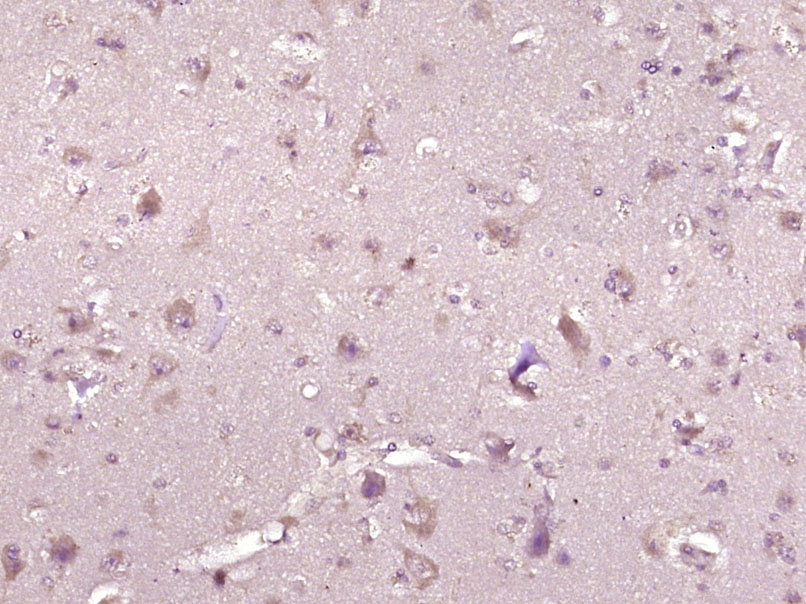
Rabbit Anti-PKD2L1 antibody
Polycystin 2 Like 1, Transient Receptor Potential Cation Channel; Transient Receptor Potential Cation Channel, Subfamily P, Member 3; Polycystin-2 Homolog; Polycystin-2L1; Polycystin-L1; Polycystin-L; PKD2L; TRPP3; PKDL; Polycystic Kidney Disease 2-Like 1
View History [Clear]
Details
Product Name PKD2L1 Chinese Name 多囊肾疾病因子1蛋白抗体 Alias Polycystin 2 Like 1, Transient Receptor Potential Cation Channel; Transient Receptor Potential Cation Channel, Subfamily P, Member 3; Polycystin-2 Homolog; Polycystin-2L1; Polycystin-L1; Polycystin-L; PKD2L; TRPP3; PKDL; Polycystic Kidney Disease 2-Like 1 Protein; Polycystic Kidney Disease 2-Like 1; PCL; PK2L1_HUMAN; Research Area Cell biology Signal transduction Channel protein Immunogen Species Rabbit Clonality Polyclonal React Species Human, Applications WB=1:500-2000 IHC-P=1:100-500 IHC-F=1:100-500 ICC=1:100-500 IF=1:100-500 (Paraffin sections need antigen repair)
not yet tested in other applications.
optimal dilutions/concentrations should be determined by the end user.Theoretical molecular weight 92kDa Cellular localization The cell membrane Form Liquid Concentration 1mg/ml immunogen KLH conjugated synthetic peptide derived from human PKD2L1: 1-100/805 <Cytoplasmic> Lsotype IgG Purification affinity purified by Protein A Buffer Solution 0.01M TBS(pH7.4) with 1% BSA, 0.03% Proclin300 and 50% Glycerol. Storage Shipped at 4℃. Store at -20 °C for one year. Avoid repeated freeze/thaw cycles. Attention This product as supplied is intended for research use only, not for use in human, therapeutic or diagnostic applications. PubMed PubMed Product Detail This gene encodes a member of the polycystin protein family. The encoded protein contains multiple transmembrane domains, and cytoplasmic N- and C-termini. The protein may be an integral membrane protein involved in cell-cell/matrix interactions. This protein functions as a calcium-regulated nonselective cation channel. Two transcript variants encoding different isoforms have been found for this gene. [provided by RefSeq, Dec 2011]
Function:
Pore-forming subunit of a ciliary calcium channel that controls calcium concentration within primary cilia without affecting cytoplasmic calcium concentration. Forms a heterodimer with PKD1L1 in primary cilia and forms a calcium-permeant ciliary channel that regulates sonic hedgehog/SHH signaling and GLI2 transcription. May act as a sour taste receptor by forming a calcium channel with PKD1L3 in gustatory cells; however, its contribution to sour taste perception is unclear in vivo and may be indirect.
Subunit:
Homotrimer; trimerization is independent of calcium-binding. Calcium channels are probably composed of 3 subunit of PKD2L1 and 1 subunit of some PKD1 protein (PKD1, PKD1L1, PKD1L2 or PKDL3). Interacts with PKD1. Interacts with PKD1L1; to form ciliary calcium channel. Interacts with PKD1L3, to form putative sour taste receptor. Interacts with RACK1; inhibits the channel activity possibly by impairing localization to the cell membrane.
Subcellular Location:
Cell projection › cilium membrane; Multi-pass membrane protein
Tissue Specificity:
Expressed in adult heart, skeletal muscle, brain, spleen, testis, retina and liver. According to PubMed:9748274, expressed at high levels in fetal tissues, including kidney and liver, and down-regulated in adult tissues. According to PubMed:10602361, expressed in fetal brain, but not expressed in fetal lung, liver or kidney. Isoform 4 appears to be expressed only in transformed lymphoblasts.
Similarity:
Belongs to the polycystin family.
SWISS:
Q9P0L9
Gene ID:
9033
Database links:Entrez Gene: 9033 Human
Entrez Gene: 329064 Mouse
SwissProt: Q9P0L9 Human
SwissProt: A2A259 Mouse
Product Picture
Partial purchase records(bought amounts latest0)
No one bought this product
User Comment(Total0User Comment Num)
- No comment



 +86 571 56623320
+86 571 56623320




